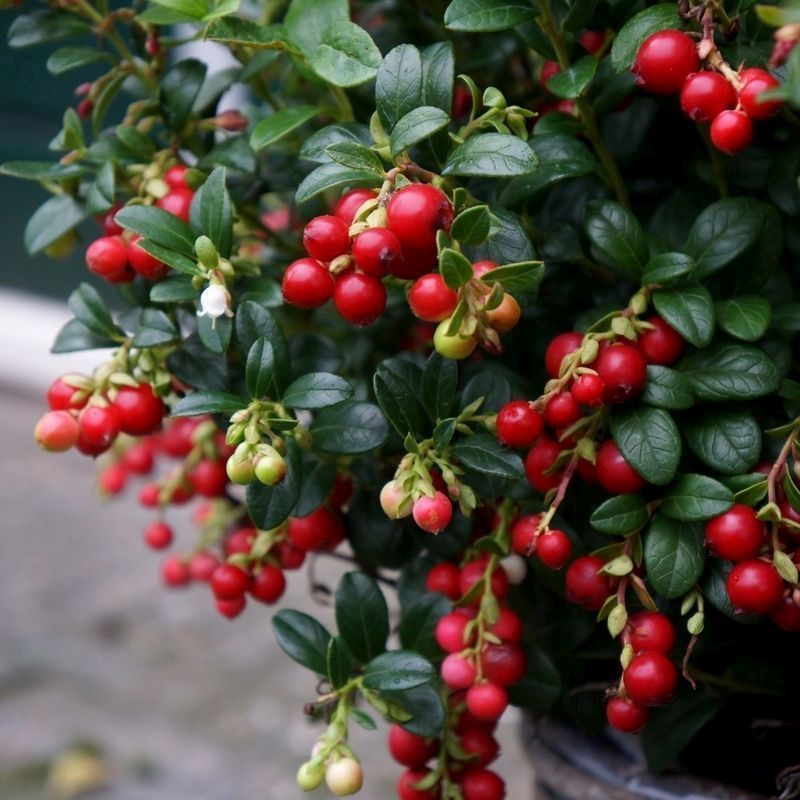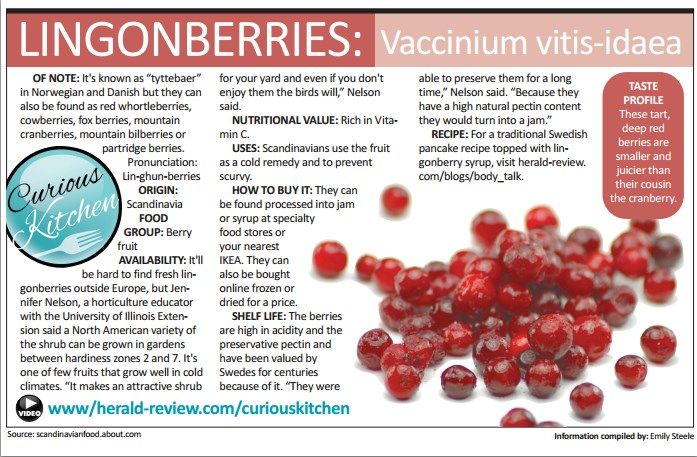
The berries are an important food for bears and foxes, and many fruit-eating birds.

They are used to make Lillehammer berry liqueur and, in East European countries, lingonberry vodka is sold, and vodka with lingonberry juice or mors is a popular cocktail. In Sweden lingonberries are often sold as jam and juice, and as a key ingredient in dishes. In this region they are incorporated into jams, syrups, and baked goods, such as pies, scones, and muffins. The berries are also popular as a wild picked fruit in Eastern Canada, for example in Newfoundland and Labrador and Cape Breton, where they are locally known as partridgeberries or redberries, and on the mainland of Nova Scotia, where they are known as foxberries. The berries can also be used to replace redcurrants when creating Cumberland sauce. In Poland, the berries are often mixed with pears to create a sauce served with poultry or game. In Finland, whipped semolina pudding flavored with lingonberry ( puolukkapuuro) is also popular. A traditional Finnish dish is sautéed reindeer ( poronkäristys) with mashed potatoes and lingonberries on the side, either raw, thawed or as a jam. In Russian folk medicine, lingonberry water was used as a mild laxative. This traditional Russian soft drink, known as " lingonberry water", is mentioned by Alexander Pushkin in Eugene Onegin. This was also a home remedy against scurvy. This was known as vattlingon (watered lingonberries) the procedure preserved them until next season. In Sweden and Russia, when sugar was still a luxury item, the berries were usually preserved simply by putting them whole into bottles of water. This was very common in old times, because it was an easy and tasty way to preserve pears. A traditional Swedish dessert is lingonpäron (literally 'lingonberry pears'), consisting of fresh pears which are peeled, boiled and preserved in lingondricka ( lingonberry juice) and is commonly eaten during Christmas. Preserved fruit is commonly eaten with meatballs, as well as potato pancakes. In Sweden, Finland and Norway, reindeer and elk steaks are traditionally served with gravy and lingonberry sauce. Fruit served this way or as compote often accompanies game and liver dishes. This mix can be stored at room temperature in closed but not necessarily sealed containers, but in this condition, they are best preserved frozen. The raw fruits are also frequently simply mashed with sugar, which preserves most of their nutrients and taste. The berries are quite tart, so they are often cooked and sweetened before eating in the form of lingonberry jam, compote, juice, smoothie or syrup. In some areas, they can be picked legally on both public and private lands in accordance with the freedom to roam. The berries collected in the wild are a popular fruit in northern, central and eastern Europe, notably in Nordic countries, the Baltic states, central and northern Europe. Lingonberry jam with mustamakkara, a traditional food in Tampere, Finland Nutrient-poor soils are tolerated but not alkaline soils. It prefers some shade (as from a forest canopy) and constantly moist, acidic soil. It is extremely hardy, tolerating temperatures as low as −40 ☌ (−40 ☏) or lower, but grows poorly where summers are hot. Vaccinium vitis-idaea keeps its leaves all winter even in the coldest years, unusual for a broad-leaved plant, though in its natural habitat it is usually protected from severe cold by snow cover. The minus subspecies is listed as a species of special concern and believed extirpated in Connecticut. Conservation status in the United States While bitter early in the season, they sweeten if left on the branch through winter.


The fruit is a red berry 6–10 mm ( 1⁄ 4– 3⁄ 8 in) across, with an acidic taste, ripening in late summer to autumn. The flowers are bell-shaped, white to pale pink, 3–8 mm ( 1⁄ 8– 3⁄ 8 in) long, and produced in the early summer. redberry (in Labrador and the Lower North Shore of Quebec).partridgeberry (in Newfoundland and Cape Breton Island).There are at least 25 other common English names of Vaccinium vitis-idaea worldwide, including: The specific name is derived from Latin vitis ('vine') and idaea, the feminine form of idaeus (literally 'from Mount Ida', used in reference to raspberries Rubus idaeus). The genus name Vaccinium is a classical Latin name for a plant, possibly the bilberry or hyacinth, and may be derived from the Latin bacca, 'berry'. The name 'lingonberry' originates from the Swedish name lingon for the species, and is derived from the Norse lyngr, or heather. Vaccinium vitis-idaea is most commonly known in English as 'lingonberry' or 'cowberry'. 7.1 In Indigenous North American cuisine.3 Conservation status in the United States.


 0 kommentar(er)
0 kommentar(er)
